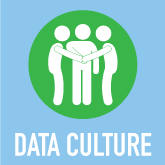Authors: Denise Mauzy and Haidee Bernstein, DaSy

A recent policy guide from the Education Commission of the States asserts that “when states treat data collection and analysis as a lesser function, they struggle to maintain a compelling vision for education data.” (von Zastro & Perez, Jr., 2019). We at DaSy agree because we know that a strong data culture has a good chance of thriving when an organization believes in continuous improvement and regularly puts that belief in practice (i.e., valuing data and using data to make decisions). So how do you move from a place where data collection and use are a box you check off and forget to a place where data are a driving force in discussions and strategic planning about how your program operates and is doing? It takes work and it requires ongoing reflection about your efforts and what you can do better. Let’s consider two scenarios about supporting and enhancing a strong data culture.
| It has been an intense and exciting 18 months. I have been working with a team of family members, program staff, stakeholders, and data people. We had a bumpy start trying to determine our focus and getting everyone speaking the same language, but we are finally having discussions about our data and trends in the data. Data used to be something “scary” or “boring,” but now it is a tool we use to inform our thinking, have discussions, and support decision-making. While I am happy with our progress, I think we can do a better job supporting team members’ understanding of the data and reports and communicating about our findings. I wonder if my team members would agree or have other suggestions. — Suzy S., Coordinator |
| I am responsible for organizing and facilitating our district’s long-standing early childhood special education data team. During my orientation (3 weeks ago), my supervisor said she expects me to breathe new life into the group. I have been reviewing meeting notes and noticed that the attendance has really declined in the past 9 months and the status of many of the items on the workplan is unknown. I reached out to a couple of team members, including two who have not attended in some time. While members expressed high interest in data exploration, they indicated that the team was not meeting their needs. I need strategies to help me get this team back on track. — Nick Newbie, Coordinator |
The main goal of data teams is for the members to work together to use data to plan and make decisions about programs and services. Data teams should serve multiple purposes, including investigating critical questions, engaging families and stakeholders, monitoring trends, addressing challenges, and celebrating successes. The number of people on a data team will vary from state to state, and some data work may be done by a team that focuses on a variety of topics including data. Suzy and Nick can tell you that thoughtfully forming or maintaining a data team is not easy. And we know that no two data teams are the same. Sometimes we become so focused on the day-to-day demands of the job that we neglect to nurture the spirit of improvement within our teams. While they find themselves in very different places in terms of development and engagement, both Suzy’s and Nick’s teams can benefit from group reflection and discussion about successes, challenges, the group’s strengths, the group’s weaknesses, and collaborative goal setting.
Suzy and Nick used the Data Culture Self-Assessment Tool posted in the Assess Your Data Culture section of DaSy’s Data Culture Toolkit to help their teams think about their approach and prioritize needs in four areas.
- Teaming: Assessing how well the team has identified its purpose and vision, determines focus areas, implements work group processes, encourages engagement by all members, works collaboratively, engages stakeholders, and represents the children and families served.
- Data management: Assessing how data are used to answer questions, how the data infrastructure is managed (e.g., identifying and addressing needs for reports), who has access to analyses and reports, and how the information is disseminated.
- Data-informed inquiry: Assessing how well the team implements the decision-making model (including training), resolves data quality issues, includes and/or accesses staff needed to perform analyses, and implements actions needed based on analyses.
- Monitoring and communication: Assessing how well the data team monitors data use progress, establishes communication procedures for outputs, completes community outreach, and shares information in an easy-to-understand format.
So, let’s see how Suzy and Nick are doing…
Suzy learned that her hunch was on target. Several team members indicated they need additional supports to be more effective team members given the complexity of the data reports. Also, the team identified dissemination strategies to ensure that the data are shared with the appropriate stakeholders in a timely manner while using the existing communication pathways (e.g., email list, newsletters, regular reports).
After using the assessment, Nick learned that members were frustrated by the old team process, with discussions being dominated by a few members. This resulted in a shift in focus from the data needs of the most vocal team members to a process where all members’ data needs were addressed. This helped facilitate a “team reset” and breathed new life and energy into the team.
If you need assistance with building and supporting your program’s data culture, the DaSy Data Culture Toolkit is a robust resource with information, guidance, and templates to assist Part C and Part B 619 program staff with building effective data teams and supporting conditions for a culture of data use at the state and local levels. If you have any questions regarding data culture or the Data Culture Toolkit, please contact DaSy for technical assistance.


